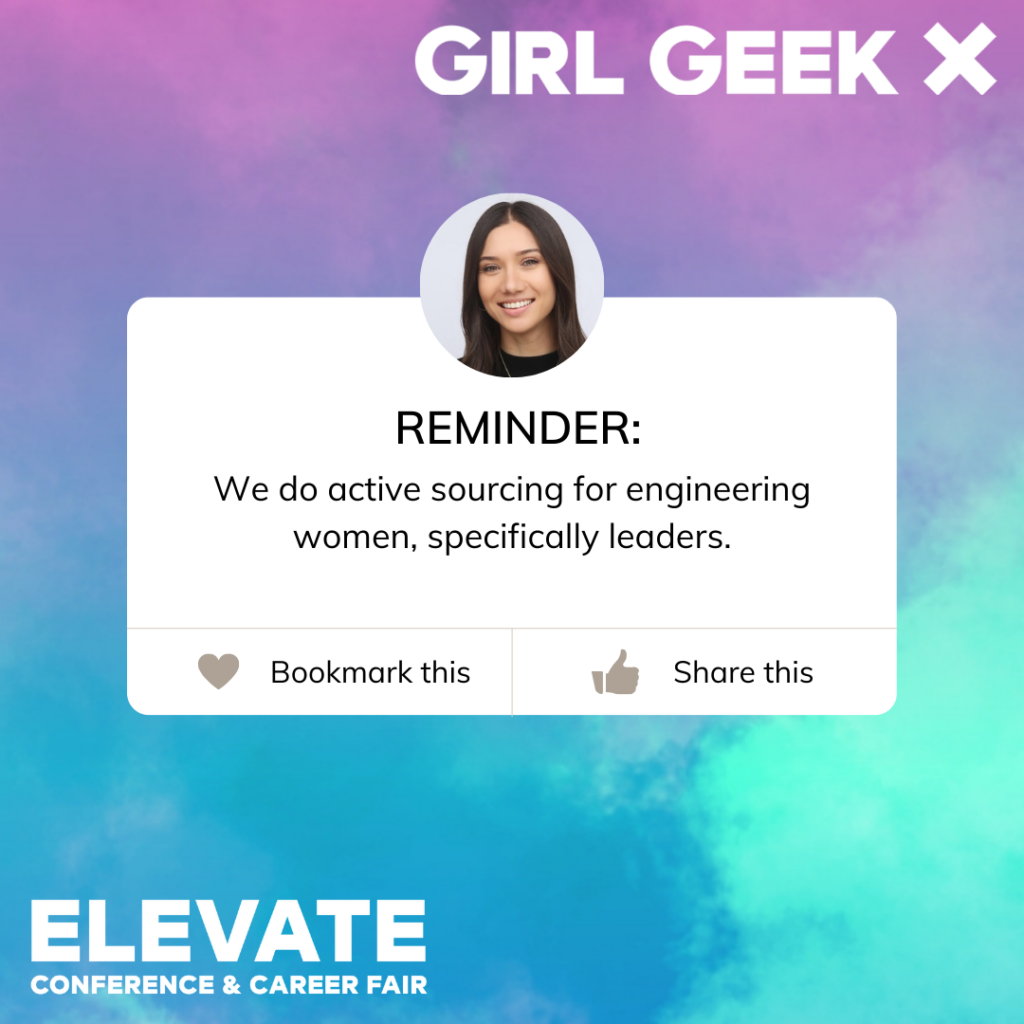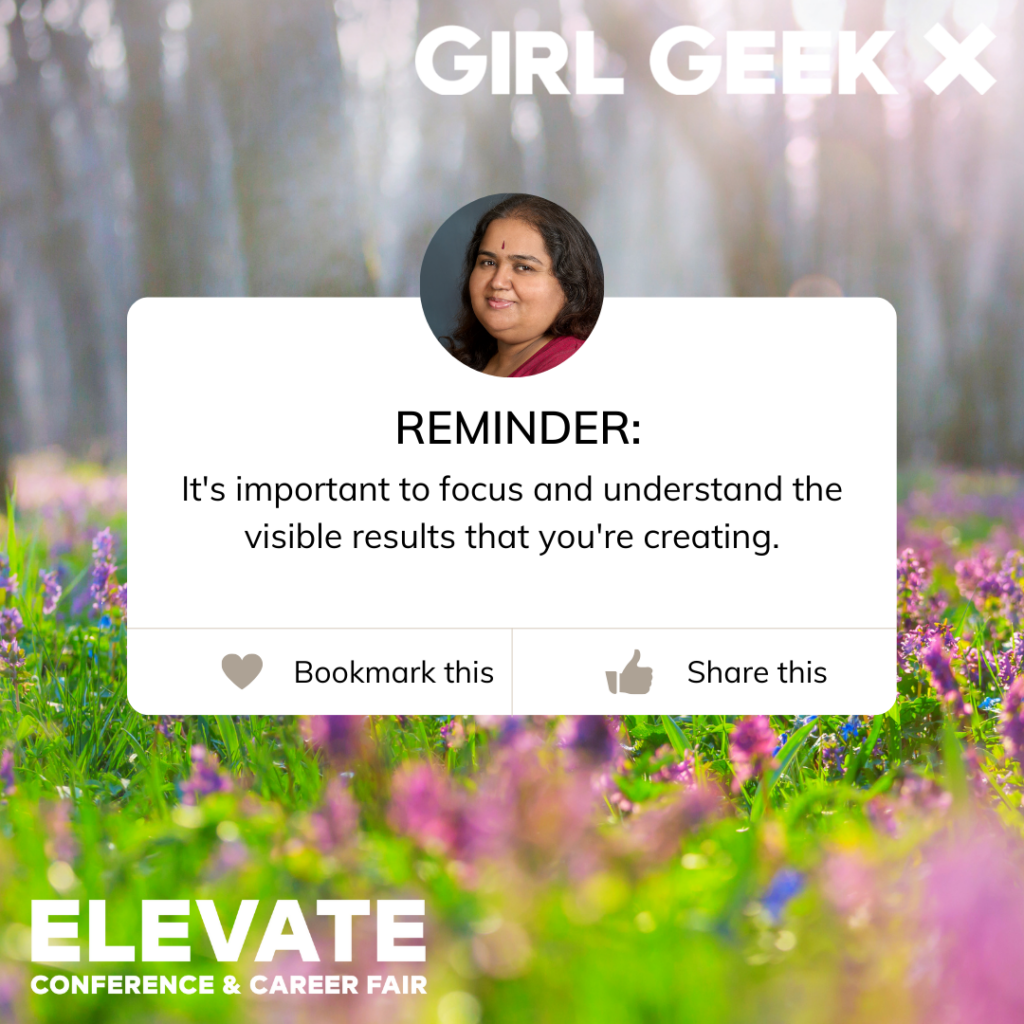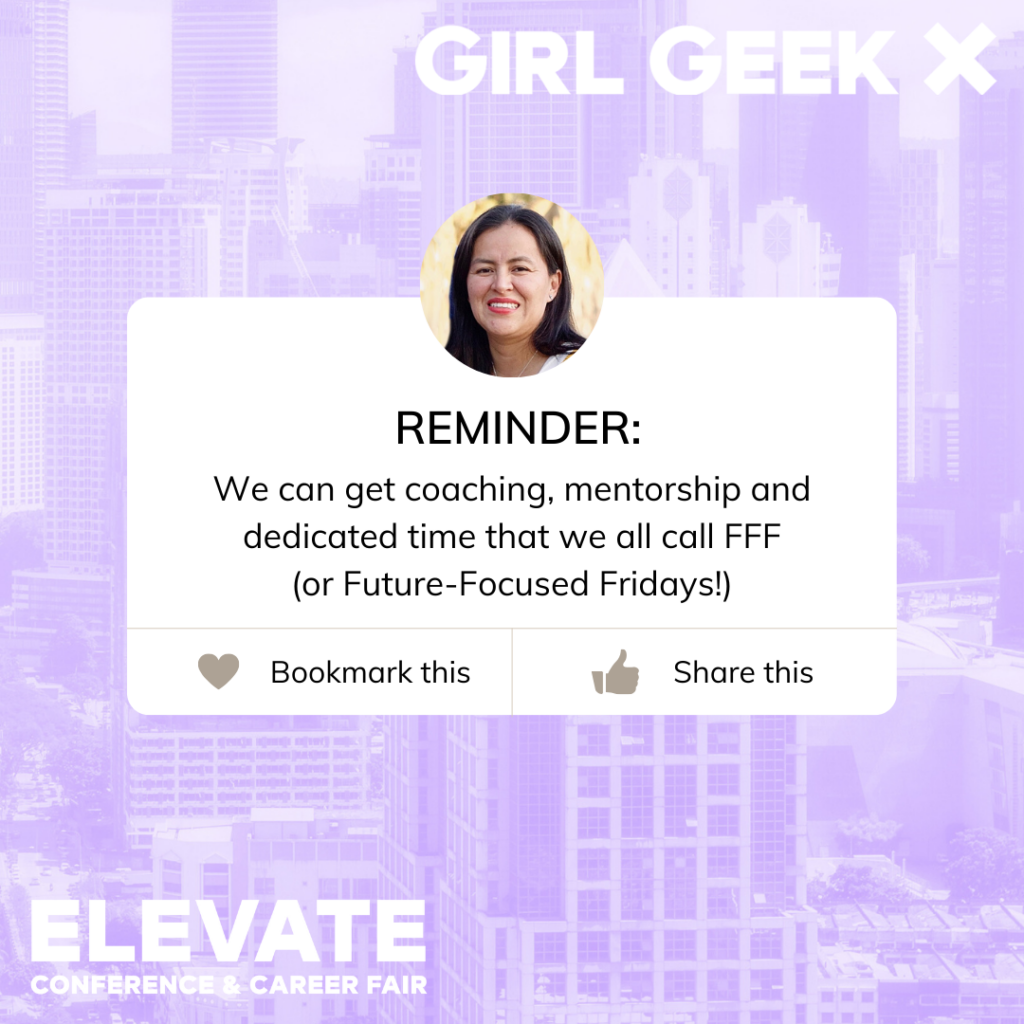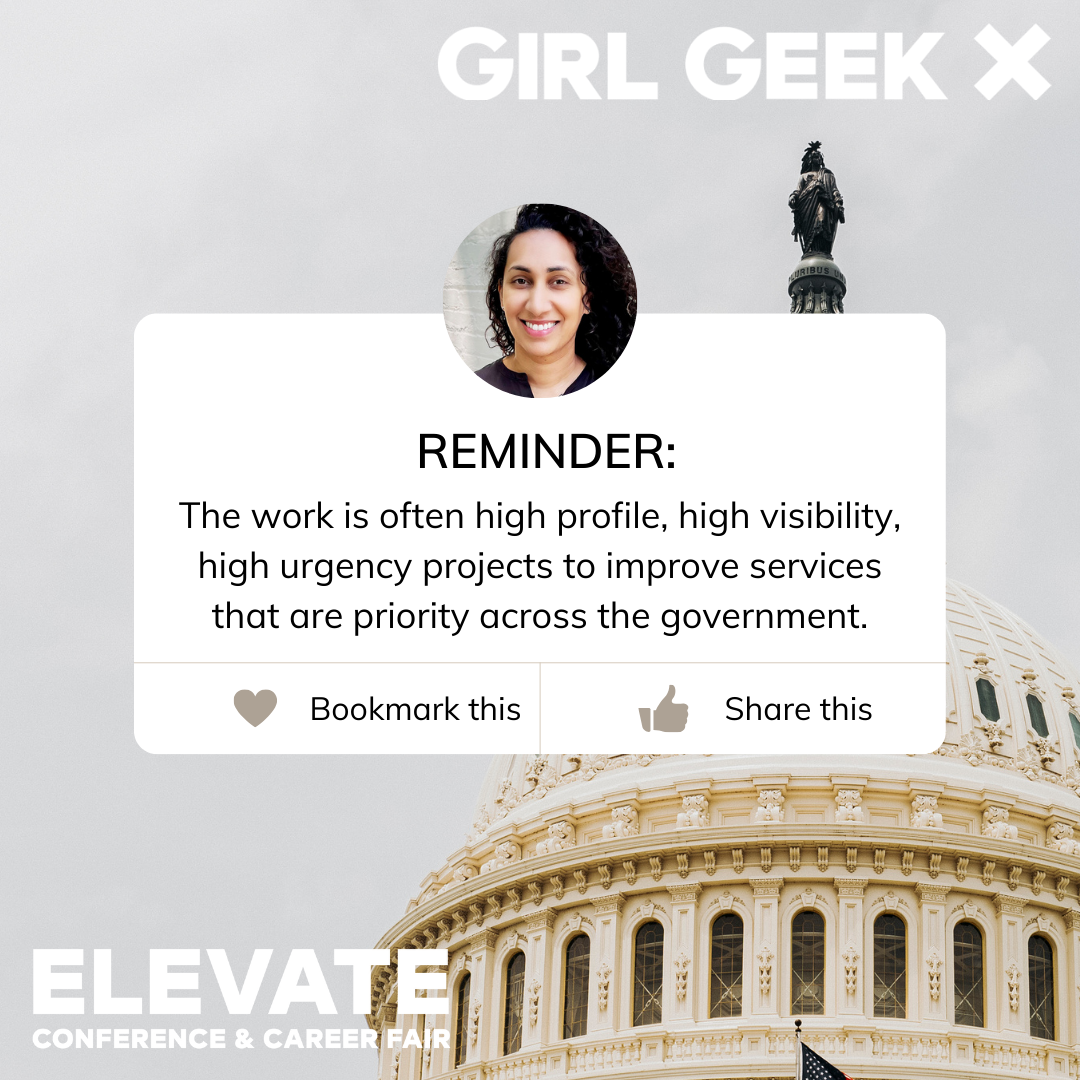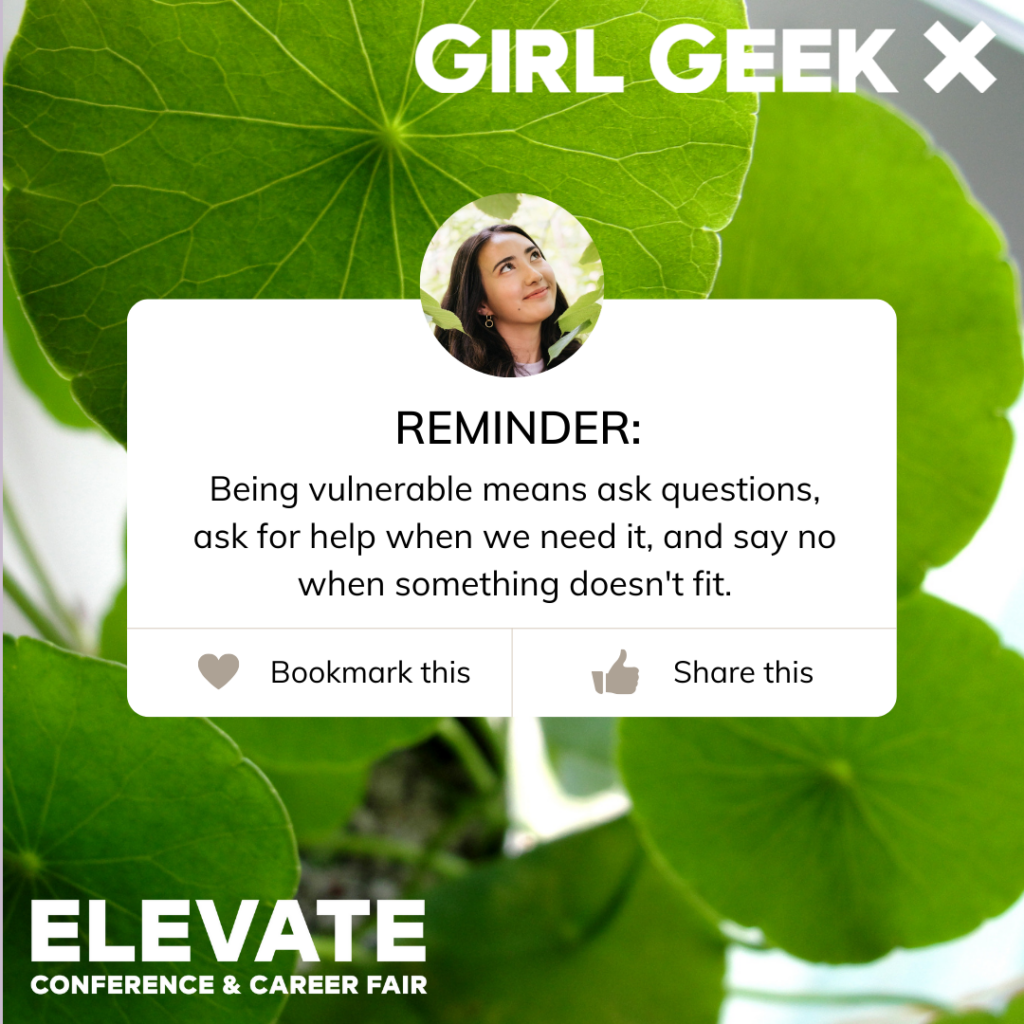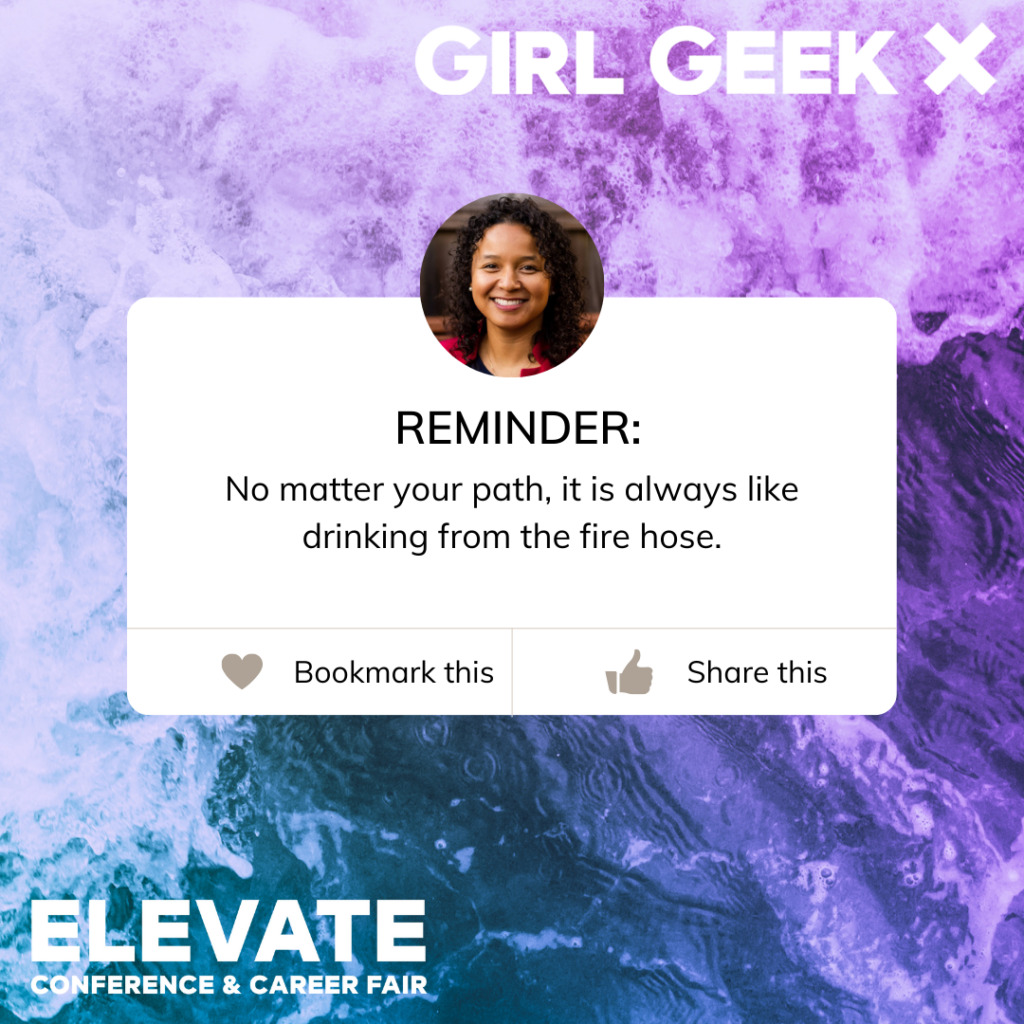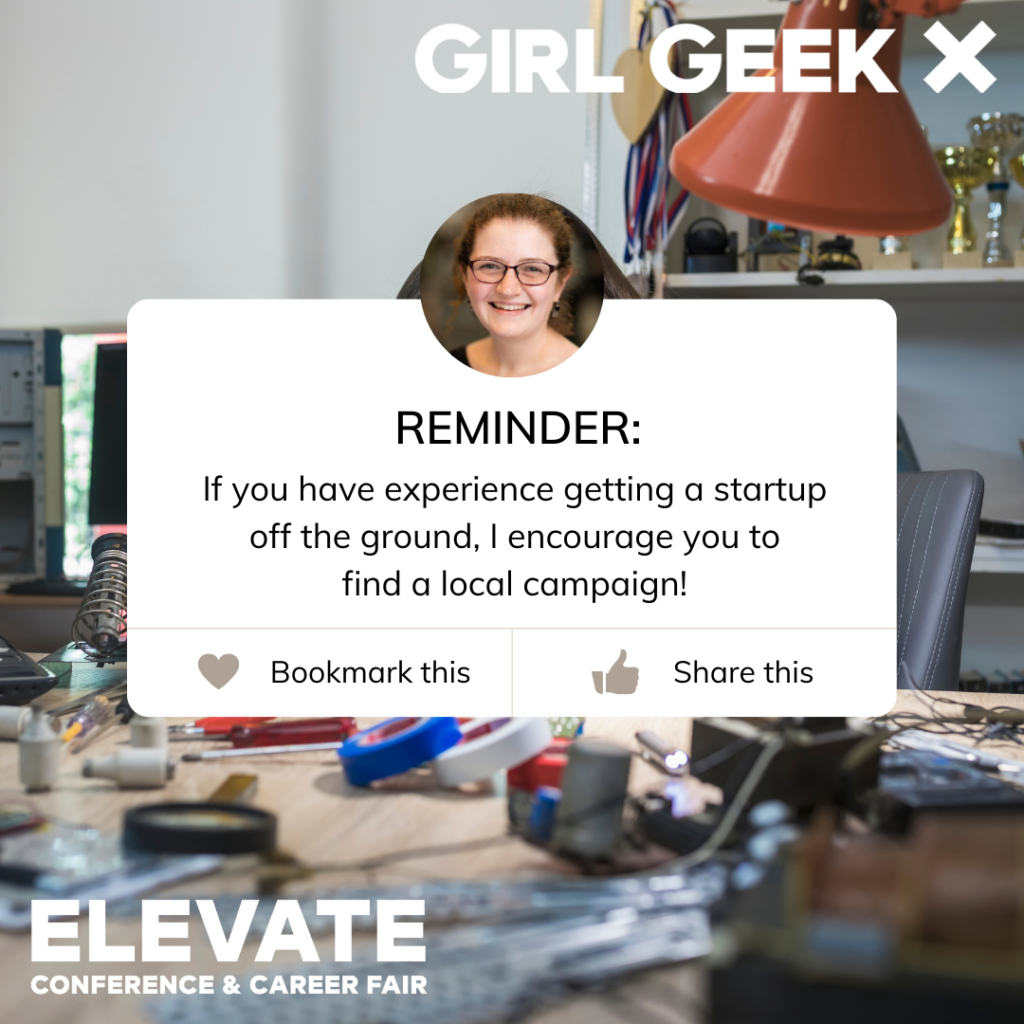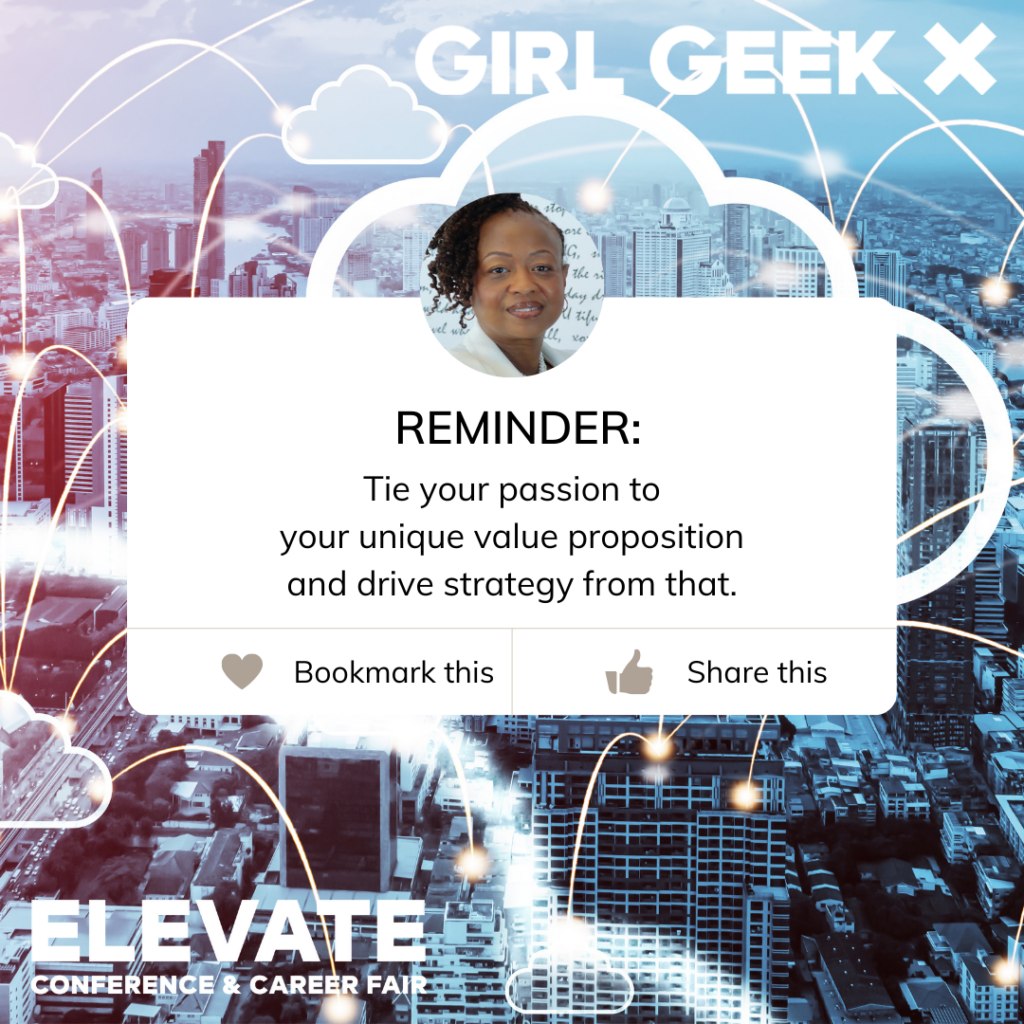In her ELEVATE session, Danielle McLaughlin, 18C Founder, discusses how to pivot to a startup leadership role and strategies for framing your experience to get to the next step in your career. She covers the importance of scoping startup roles and selling oneself in interviews, as well as tips for valuing equity packages in early-stage startups.
Like what you see here? Our mission-aligned Girl Geek X partners are hiring!
- Check out open jobs at our trusted partner companies!
- Watch more ELEVATE 2024 videos from the event, or just the “Best Of 2024” Videos!
- Does your company want to sponsor a Girl Geek Dinner or Virtual Conference? Talk to us!
Transcript of ELEVATE Session:
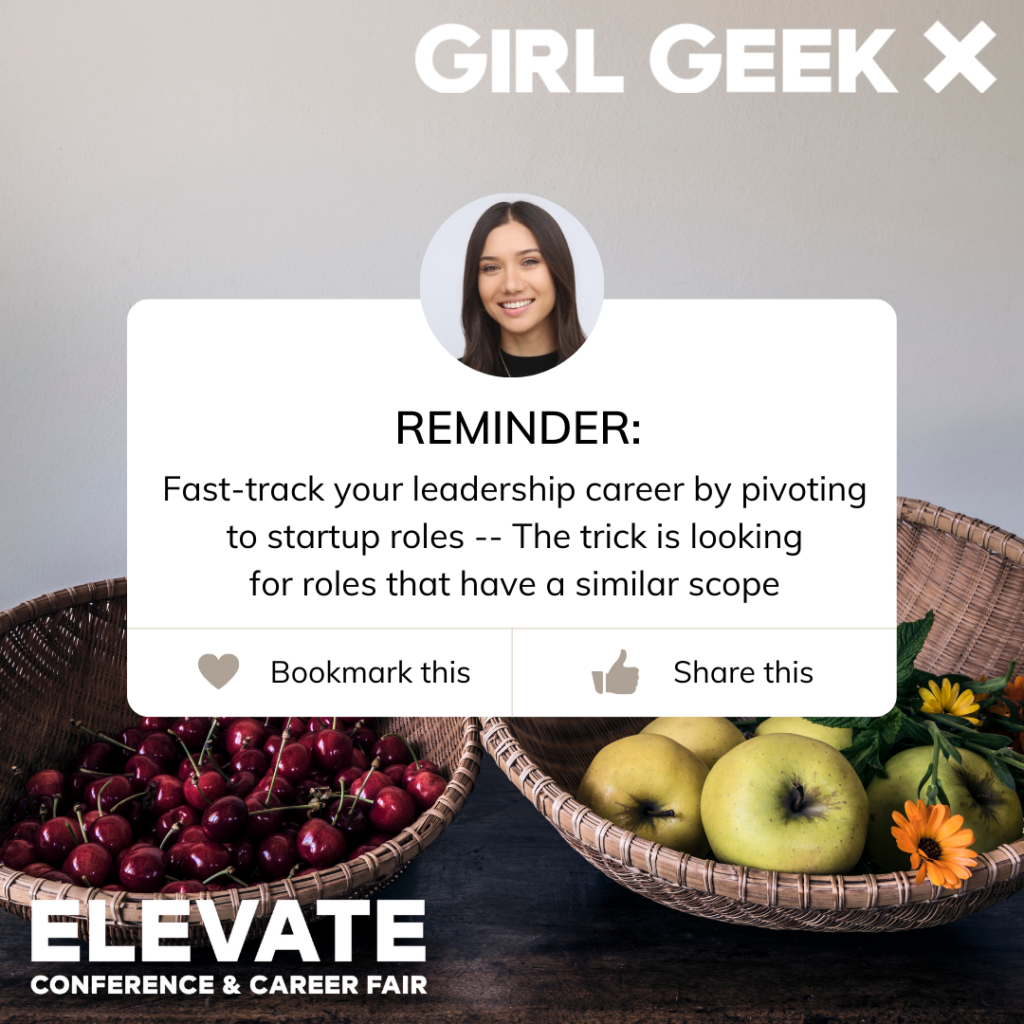
Danielle McLaughlin:
Hi. Thank you so much Angie. Excited to be here again. My name is Danielle. I am the founder of 18C, which helps women and engineering leaders find impactful roles. I hosted a session earlier today to tell you more about what I offer. I’ll do a quick recap of that today. I’ll also be talking about how to pivot to a startup leadership role, strategies for talking about your experience, getting to that next step in your career. I speak to a lot of incredible up-and-coming female leaders who have an idea of where they want to be, but don’t know how to sell their current experience or get their foot in the door at a startup. We’ll cover more on that today.
I’ll quickly flash today’s agenda, a little bit about me, 18C’s mission and services. Then we’ll pivot to startup scoping, selling yourself and how to talk about equity. This session will be a little under 20 minutes, so I’ll leave time for questions at the end. So feel free to hold onto those or add them in the chat, and let’s get started.
A little about me. I’ve been recruiting for about 10 years at tons of big companies, little companies from two to 10,000 people. I got my start in executive recruiting in the higher education and nonprofit sector. I have been really specialized in engineering recruiting since then at fast-growing businesses like Square, Lyft, Blend, Fitbit, Waymo, just to name a few. I’ve also taken on leadership roles as the head of talent at a few early stage startups, and advised and built communities for technical women. Outside of work, I’m a big dog lover, avid yogi. I’ve been teaching yoga for fun for about 10 years and I love to be active.
A bit more about why I started 18C. I actually grew up with a mom in software engineering. I used to go to work with her as a kid in San Francisco and I remember her being the only woman in the room, on her floor. I continued to see this as I got further into the tech industry and now I’m really passionate about bringing balance to the technology sector.
Some of the best businesses that I’ve worked with have really prioritized diversity and given women a voice in the organization at the leadership level. I really believe that the more women there are in the room in engineering leadership positions, the more balanced our tech products will be. The 18C name is short for 18 cents, which believe it or not, is the average difference between what women and men make per dollar in the US and that has not changed that much in the last 20 years. So it is a reminder of that balance or imbalance and striving to improve that.
All right. I’m early in my startup journey in starting a business, I’m excited for my brand to evolve. But today I’m working with businesses that want to build their teams mindfully by connecting them with exceptional women. For women, we offer job introductions, negotiation, coaching, and podcast features. We also work with startups of all sizes that really care and want to invest in diverse teams.
I’ll quickly flash a few of our open roles. You can see there’s a good range of company sizes and stages. These roles update weekly or every couple of weeks as I bring in new companies into the network. If you’re just starting to think about a search, working with a search firm in this way early on is a great way to supplement your job interview pipeline, get to the top of the stack in terms of standing out against other candidates. You can view all of our open positions at 18cpartners.com.
Today’s focus at 18C, we believe working with startups can really accelerate your leadership career. We’ll be doing a quick review of what we offer at 18C in case you missed today’s earlier session. We’ll also cover strategies for mapping larger company experience to startup experience, selling your experience as a leader and tips for negotiating equity, which is quite a complex topic. We might not get into everything today, but happy to answer one-on-one questions today too. To help translate this advice into a real world example, we’ll map out how to get to a director role from an engineering manager role in a couple of slides.
A quick recap of our services, what we offer for women in engineering before we begin. The first one is job search support. Our job search support process involves a few quick steps. You can sign up for our network or you can apply directly for a role on our website. We’ll reach out to you to schedule time, get to know you over a quick Zoom chat or phone call. Talk about what’s important to you, what your goals are, and what your job search preferences are, and we’ll email you with new roles as they come in.
You can get introduced directly to the hiring manager or jump straight into the technical screen. There’s no need to do another recruiter screen if you’re talking with us. We work with startups of all sizes and stages. Again, looking to invest in building diversity so you can really trust that these teams care about bringing women into the organization.
Secondly, our negotiation coaching services. So we support women who have job offers from other companies that we don’t work with, but still need help. Over one to two calls, we’ll get to know you in your unique situation, help you with the talk script handling different questions, sharing relevant data for your unique offer, and we’ll also go through some exercises to make sure you’re clear on your goals.
Negotiation support is probably my favorite service that we offer. I love helping women feel empowered to ask for more, to help get to the next level. So far we’ve helped women get as much as 20K on their base salary or significantly improve their equity package. I’ve also helped someone negotiate a level increase on their title and responsibilities. I recommend signing up for this at the beginning of your search. A successful negotiation really starts the moment that you start talking to a company, so the earlier, the better.
We also offer benchmarking. So if you have an offer and you just want to know how much more can I get on this offer, we can do a quick analysis. When signing up you can also express interest in this on the typeform on our network sign up page. We’re also offering a special discount, 20% off. So look in the chat for that discount code. Thank you Mariela.
And last but not least, 18C is starting a podcast so we’re looking for leaders who have a unique story to tell. The goal of this is really to highlight inspiring women in technical leadership roles, having them share their stories so that other women can chart their own path and really stay rooted in the tech industry. I’m excited for the first launch of this. This is a great way to grow your social media brand, practice public speaking, tell your unique story. So feel free to subscribe for that on the network forum on my website as well.
All right, so jumping into the meat. Startup roles scoping. In this section, we’ll want to answer a question, how do I find roles that I’m qualified for at a startup? The goal of this is actually to help you narrow in on what types of startup roles your experience would translate well to as an engineering leader. The current hiring market is really saturated for everyone. So making sure you’re applying to the right roles is really crucial to getting through the early stages of the interview process.
Let’s start with an example. You are an engineering manager at a midsize company. You’re thinking about a job search. You know you really want to get to the director level in your career so you can work closer with products and have more ownership. In the past you’ve been maybe a senior software engineer at a large tech company or maybe you’ve interned at another startup.
You’re seeing your peers land director roles who have no leadership experience or some of them are even going from individual contributor to CTO, or head of engineering. And this is really confusing. You’re thinking, “How do they get those roles? Am I qualified to make a move like that and how do I determine that?” The key to answering this transition is finding a role that has the right amount of scope and challenge for your unique place or where you’re at in your career.
To break this down, let’s imagine there are a sea of other candidates looking for this director role. Some of them also have the same experience as you on paper. Their resume also states they’re leading a team of 10 engineers. And different titles at different companies are going to have the same responsibility. In some cases, a staff engineer might be doing the same work as a technical lead, or an engineering manager might be doing the same work as a senior engineering manager.
Recruiters at this stage will be screening you on this first call to figure out if you have what they need. The question is how do we stand out here?
Before you start applying to roles, you first need to understand and define your scope. Your answers to this question or these types of questions around ownership and understanding how your work fits into the larger goals of the business are key to unlocking some of these higher level leadership roles. This also helps you to understand where your growth areas are and what you can tackle next.
Here’s an example of some questions that might help you define your scope and create a pitch to sell yourself in this process.
We’ll cover this again in the next section, but some of these defining questions might be, how many people did you directly manage performance for? Not just technical work, but interview…performance reviews.
The second question, did you own any projects or products from concept all the way through to release? Or did you see the full life cycle of the product? How did you grow the team over time? Maybe you started with a team of two and you grew to 10? And who did you collaborate with in the business?
This is a big one that comes up and it signals your level and scope and impact in the organization to make sure to have that really solid. These are just a few questions that you’ll likely be asked in the first interview to assess whether you’re a fit for this startup’s needs, so moving on, once you’ve gone through this exercise, you should really have some concrete bullet points that summarize you well.
These points should help you start to narrow the right roles and positions that you’re applying to, look for leadership roles that really have the same number of direct reports, or maybe are in a similar product area to really get your resume to the top of that funnel. In this example, I think your experience might translate well to a Series A startup that has a team of 20 engineers where you might lead half of that team to start.
The scope of your role is actually quite large, owning half of the organization, but you’re a direct match because you have led a team of 10 full stack engineers in the past, you’ve managed managers.
The trick here is looking for roles that have a similar scope. This role might actually be titled, engineering manager, but you can grow with that team over time and the scope of the role at that startup is really at the director level.
Selling yourself. You’ve now determined what size and stage of businesses you might be looking for. You need to get really good at selling yourself. We’ll talk about how to translate those experiences in an interview. I love this imagery in this formula because it really builds our experiences on top of one another, starting with your scope as the foundation and the core selling point of your experience, followed by your impact and demonstrating growth. We’ll take the bullets that we worked through in the last section to tell a unique story about why you’re a perfect fit for this opportunity.
Using that previous example, I was an engineering manager at an early stage Series D company. I managed 10 full stack engineers with two engineering managers underneath me. My team grew revenue for three consecutive quarters. I started with two engineers and grew the team and took on new products, and now I’m ready to lead a larger group at a smaller company and make a bigger impact.
The top of this pyramid should always be about where you’re going next. And the last sentence in your statement should really emphasize the excitement about taking on this new challenge at a smaller place. And what we’re doing here is really telling a story. Startups are also on a journey. They’re also telling a story of who they are and they’re also anticipating growth. So you want to show that you are ready to take on growth at that larger leadership level and you have the experience, the same amount of scope that they’re looking for.
Okay, so shifting gears a little bit. You’ve landed an offer at this startup for a director role and maybe it’s called Engineering Manager. And you are presented with an equity package with early stage options. You’ve worked in a startup before as an intern or maybe in another scenario, but this role is much higher stakes because you’re impacting the trajectory of the company. You’re leading a team.
How do you value this offer? This is a really complex topic, I will admit. I’ve spoken about equity and compensation negotiation at a previous Girl Geek Conference, and I do one-on-one coaching for these specific situations, so definitely we can talk about some scenarios or one-on-one chats in the Q&A section or please reach out to me. I love doing this stuff.
Maybe the most important thing in understanding how to get more equity in the early days of a startup is understanding what stage you’re joining in the company’s history. Questions to ask here might be, how much equity has already been distributed and how many other leaders are there in the business? There’s some deeper questions around the fundraising amount valuation that should be considered here, but usually you have that information at the start of your search. In this stage, you really want to talk about what the current environment is for the equity pool.
Not every founder is going to be willing to share their cap table with you or share the number of shares they have distributed already. But if you’re going to be a contributor, a leader at this early stage, it’s really important that the founders are transparent with you about their compensation philosophy since you are going to be recruiting people to their team and you’re going to have to sell this equity too.
The next step would be understanding market data. You might ask some questions here around, how are other companies in this industry and sector valued? This is a big one for looking at the potential viability of the product. So for example, if you’re building a product in the streaming space or a startup in the streaming space, you want to go look at Netflix. How much money is Netflix worth? What’s their stock trading at? That should give you an idea of market share and sizing, and this might give you a potential idea of what potential future growth of that stock might look like.
The second is, what are the current rates for this type of role on the market? You can check public resources on recent offers at the same size and stage. This data does not always come into play, but it’s pretty useful to have in final conversations. Meaning, you may not bring it up with the company but it’s good for you to know benchmarking, how much room do I have to go up or down?
One of the biggest mistakes I think I see when leaders transition to a startup from a big tech company is asking for a direct conversion of their public equity shares. The reason this doesn’t work is startups really look at potential future value of equity and not current value. It’s fine to talk about compensation, to share where you’re at if you’re comfortable sharing your current comp. Sometimes your recruiter will really value that and help to build a package that is meaningful to you. But every company will have a different set of variables influencing their valuation, the potential price per share. And that influences your total equity package, which will fluctuate over time.
A better way to approach this using the data that you’ve already gathered in the process on the company’s valuation, their industry, et cetera, is to look at how long it will take you to get the same potential return on investment for that equity package. Meaning, maybe the company only needs one to two more fundraising rounds to match your current equity at your big tech company, and potentially it will exceed that value over time.
At 18C, during our negotiation coaching, I do offer a calculator that shows you how to value stock today, how you can look at potential future growth over time. And that will help you in this conversation to ask for more. There’s a lot more strategy I can share here. Again, I offer coaching on this topic. I love doing this stuff, so feel free to reach out to me and then I can also answer questions today.
That’s it for today’s session. We have about 10 minutes for questions. If you want to get in touch with me, you can add me on LinkedIn here, sign up for the network to access jobs, negotiations, support and apply to be on the podcast. But let’s start taking questions.
Mariela has been rounding up the questions in the chat. Thank you, Mariela, who is on my team. Let’s see.
Please talk about the current marketing conditions and when you think things will be improving. That is the big question, isn’t it?
I actually have some interesting thoughts on this topic. So when I worked at Square many years ago in 2016, we were also having a big election. I remember one of the C-suite leaders and Jack Dorsey actually also at the time talking about, “Before big election cycles, there’s usually a dip in hiring,” and that happens for a couple of reasons. Investment money moves before big elections.
Also, there’s a lot of fear that happens in the market. So without the current macroeconomic conditions, I would expect the hiring market to go down a little bit right before a big election. I think it’s amplified right now. While we might be seeing a little bit of a rebound in positions opening in tech and some of the layoffs are slowing down, things, I don’t think, are going to return to normal until Q4, and I’ve read that in a couple of different areas.
That is my prediction, but I do definitely see that happening historically in my career. The couple of months or the year before an election cycle, things drop a little bit. So take that for what you will. I mean, I think interestingly, Q1 is always the craziest time for us in the hiring world. There are little peaks and valleys, so Q1 is a big one. The beginning of Q3, interestingly, or the end of Q3 maybe.
September when kids go back to school, October tends to be a really big month for hiring. I’m interested to see how the seasonality and how the election affects this upcoming situation in the hiring market. But that’s my two cents, or 18 cents, if you will, but really good question. I love hypothesizing about that stuff, so thank you.
Let’s see. I’ve been having a hard time pricing myself out of salary ranges, but trying not to sell myself short. I’ve made much more than the salary range for jobs that I’ve interviewed for maybe like 25K more.
Yeah, I’ll definitely say so there was a new law passed a few, maybe I think… In the beginning of 2023, a new law was passed that requires employers to post their salary ranges on the job postings. This is very interesting for tech companies, especially large tech companies because they operate their interview pipelines on a very large scale.
You might see a salary range on a job posting that is not exactly correct, meaning you might interview for one role and at a certain level and they might offer you a position at a different level. I would definitely still apply to jobs. If you see a slight difference on the salary range, talk to the recruiter. Ask them, “Hey, I saw the salary range. Is this accurate? Can I make more or less than that?” And that’s a good time to benchmark with them on what is the likelihood that I can get more on this offer.
You don’t necessarily have to share your comp in that call either. So you don’t have to say, “I make X, but the role’s posted for lower.” You can just say, “Hey, my base salary is a little out of range here. Would love to know more about is the salary that you posted on the job posting, is that true? Is there some flexibility there? What about equity? What about bonuses?” Really build the relationship with the recruiter at that point without sharing too much information, I think can go a long way. That’s a great question.
And then moving to another one, let’s see. As a CEO and founder, did you experience any challenges or obstacles when first starting out? Well, definitely I think [inaudible] end up staying on a long time because I really loved it. I’ve also worked at a 10 person company and other sizes and stages of startups growing from there. I took steps in my career to learn how a business runs, went to smaller and smaller companies to pick up more of that knowledge before I jumped into this, which helped prepare me a little bit. I think I know my ultimate goal has always been to start a business. My dad started a business, ran it out of our home for the majority of my life. So I have that anecdotally to refer to as well, but it’s still very, very challenging.
I think one thing that keeps me going is I really care about what I’m doing. As I said, my mom is a software engineer. So I feel really connected to supporting women in this space, helping really solve some of the things that I saw firsthand working in the tech sector for so long. I think other challenges might just be working solo, solving every single issue that comes up, knowing that there is so much work to do, so many things you need to fix and there’s no way that you’re going to get them done this week or next week. So you’re really in it for the long haul. That can be really daunting.
I think if you’re thinking about it, definitely a great thing to think about is what’s your support network when you’re jumping into something like this? Because you’ll definitely need people in your life who are encouraging you. You’ll need resources when you can’t take care of your family members or if you have to jump into something. So a lot to consider. But so far I’m really enjoying it. And feel free to ask other questions in the chat if you have any.
Another question came in. Will you expand your business to product program managers in the future? I’d definitely love to. I’m starting in engineering because that is my area of expertise. That’s where I’ve been recruiting for the longest. I also see the biggest pain point, I think, for women in the space, being the minority in the field. I do have other recruiters, though, that I partner with who we share candidates, roles across our network. So for example, I have someone that specializes in climate tech businesses, someone that specializes in Bitcoin or crypto companies. I’m really considering those partnerships and expanding there. But I definitely love working with anything in engineering product and design. So that would probably be the first place that I pivot if and when we get there.
Are there certain titles you’re looking for for podcast guests?
Yes. We’ve recorded a few. Mostly the women that I’m chatting with are engineering leaders or product leaders. And I’m really looking for women who have a unique story to tell, but also women who want to help inspire other women to stay in the space. Interestingly, my mom is a software engineer. She went through the dotcom boom and then the layoffs that happened after that and she pivoted. She did not stay in engineering and software engineering. And I think it’s so important to encourage women to stay in the space. A lot of us have pressures to start a family, to move on from this space, and making businesses and teams more inclusive to allow for women to stay in the space is super important. So I love talking to women that have something to say about that.
And aside from that, oh. One more question, director level and above.
I do work with people at all different sizes and stages. For product managers you can apply to the general posting on my website and happy to share more details there. I see Angie popping in, which means that the session is going to be over soon. So feel free to apply. Add me on LinkedIn, would love to chat with you and share more about the services.
Angie Chang:
Thank you so much. This is a really great presentation. I love some of the slides. They’re on Twitter now. Thank you, Danielle.
Like what you see here? Our mission-aligned Girl Geek X partners are hiring!
- Check out open jobs at our trusted partner companies!
- Watch more ELEVATE 2024 videos from the event, or just the “Best Of 2024” Videos!
- Does your company want to sponsor a Girl Geek Dinner or Virtual Conference? Talk to us!


